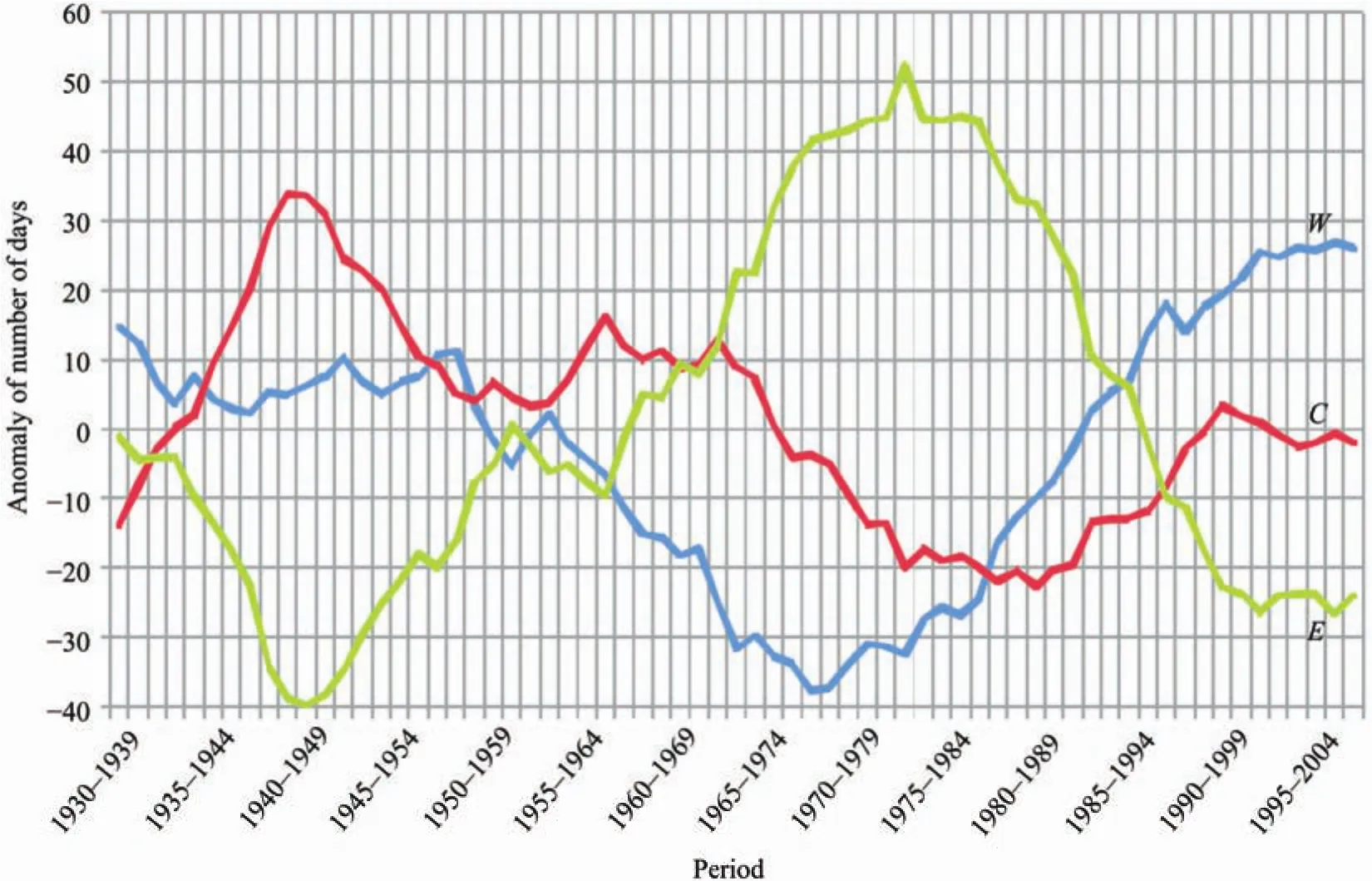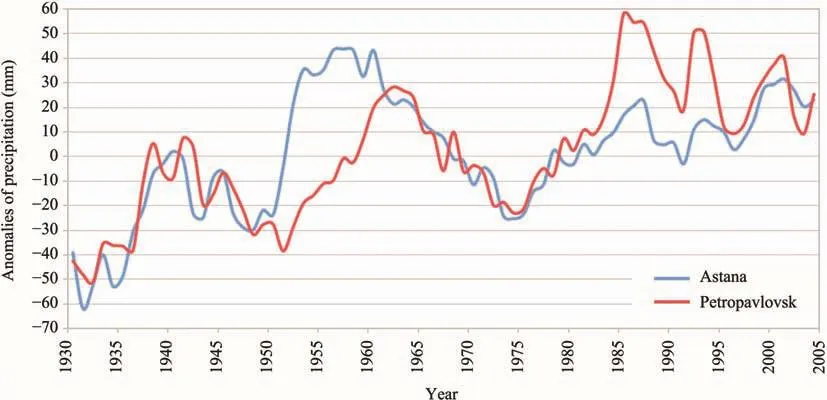Climatic variations of general atmospheric circulation,precipitation and river flow of the territory of Kazakhstan
Vitaly Salnikov , Galina Turulina, Svetlana Polyakova, Marat Moldahmetov,Lyazzat Mahmudova
Department of Meteorology and Hydrology, Faculty of Geography and Environmental Sciences al-Faraby Kazakh National University, Almaty, Kazakhstan
1 Introduction
In order to prepare effective water resource management plans, there is a need for careful consideration of current and projected changes to water resources and regimes of a river basin, under the influence of both natural and anthropogenic factors. The importance of these plans has become increasingly apparent in the past decade as many areas have begun to experience the effects of climate change. In the mid-latitudes of the Northern Hemisphere, there has been an increase of air temperature observed since the late 1970s and early 1980s.
Methods for calculating the basic hydrological characteristics of a river system, as well as planning for the long-term use of their water resources, have been based on the principle of stationarity of long-term flow fluctuations.However, scientific data is increasingly indicating that there are long-term changes occurring to climatic conditions, affecting things such as river flow, precipitation and air temperature, as well as impacting on the assumption of stationarity of these conditions.
Such data indicates that there may be long-term fluctuations occurring to general atmospheric circulation as a result of climate change, and leading to changes in meteorological processes.
It has been established that there are differences in the formation of river flows in Kazakhstan, depending on the type of atmospheric processes that influence an area (Battalov, 1968).
The purpose of this paper is to study the effects of gen-eral atmospheric circulation on the water regimes of river systems, based upon a comparative analysis of the variability of annual precipitation and river flows in the Ishim River Basin of Kazakhstan, utilizing theW,CandEclassification system prepared by G. Y. Vangengeim (Vangengeim, 1952).
2 Description of research method
At present, there have been a number of studies discussed the long-term fluctuations of global air temperature and precipitation (Baydal, 1964, 1971; Gruza and Rankova,1991; Dolgih, 1995; Gruza and Meshchersky, 2008). Of some interest are the studies of atmospheric circulation by the instrumentality of generalized characteristics, including existing indices and classification of synoptic processes over the Atlantic-Eurasian sector of the Northern Hemisphere(Gears, 1971; Subbotina and Chevychalova, 1991; Anisimovet al., 2009).
One of the best known is the classification by G. Y.Vangengeim, in which all processes of general atmospheric circulation (GCA) are summarized in three forms: the western (W), eastern (E), and meridional (C). Western meridional circulation forms theW-Zoneand is characterized by the transfer of air masses in the troposphere, resulting in waves of small amplitude rapidly shifting from west to east.Whereas processes classified asEandCrepresent the meridional atmosphere and the troposphere respectively, corresponding to stationary waves of large amplitudes(Vangengeim, 1952).
The eastern form of circulation is characterized by a high-altitude ridge over the European territory of Russia(ETR) with two troughs directed to Greenland and to Europe from areas of western Taimyr, Siberia and Kazakhstan. The meridional circulation is characterized by a high-altitude ridge over the eastern Atlantic and a second ridge over Kazakhstan and Western Siberia as well as an altitude trough over the European territory of Russia.
The numerical characteristics of the classification are as follows: the number of days with some form of circulation(NW,NE,NC) or days with anomalies(ΔNW, ΔNE, ΔNC). The study of long-term variation of atmospheric circulation in this paper was undertaken by assessing the frequency of circulation formsW,EandC, for the period of 1891–1972(Gears, 1971), and from 1972 to 2004 (Dmitriev and Belyazol, 2006).
The long-term variability of large-scale atmospheric circulation processes from 1930 to 2006 is presented in Figure 1 as deviations from the norm. This figure highlights certain time periods that have been dominated by particular climatic processes.

Figure 1 The long-term variability of large-scale atmospheric circulation processes (as deviations from the norm)
3 Analysis description
Areas of particular interest in Figure 1 are those years of significant deviations from the averages of days with some form of atmospheric circulation,i.e., the time when the frequency of one form or another is ≥40% of the total number of cases of deviation from the norm of 30 days (Table 1),because such mode of atmospheric circulation may determine the large anomalies of precipitation and river runoff.
It should also be noted that in the second half of the 20th century there were a series of large positive anomalies observed in the macro-circulation processes. The largest posi-tive anomaly of formEwas observed in 1981 (262 days,i.e.,up to 94 days more than the norm), of which the process had an average continuous duration of more than 10 days. The most significant anomaly was observed in formCin1947(154 days, including 62 days more than the norm). The frequency of the zonal circulation pattern is always less than the frequency of the meridional. However, in the last decade of the 20th century and in the early 21th century,this form of circulation was prevalent and in 2000 it amounted to 157 days, 52 days more than the historical averages.
For comparison, in this study we also marked the years when the number of days with each form of circulation was close to historical averages. Of the 75-year series of observations, only four years met this description. This was 1955(W: 109 days;C: 90 days;E: 166 days), 1982 (W: 106 days;C: 91 days;E: 168 days), 1987 (W: 104 days;C: 92 days;E:169 days) and 2001 (W: 107 days;C: 90 days;E: 168 days).During these particular years, large-scale processes only differed slightly from the historical average, mostly 3–7 days and rarely exceeding 10 days.
There are numerous papers (Battalov, 1968; Baydal,1971; Drozdov and Grigorieva, 1971; Anisimovet al., 2009)which have demonstrated convincingly that atmospheric circulation has the capacity to affect the distribution of air temperature, precipitation and influence river flow. However,rainfall can also be heavily influenced by local physiographic conditions that can weaken the overall spatio-temporal patterns of distribution determined by the nature of atmospheric circulation. As a consequence, the distribution of precipitation over the territory is not an even distribution.

Table 1 The years of maximum positive anomalies in the number of days with various forms of atmospheric circulation and corresponding precipitation anomalies
The data presented in Table 1 indicate the anomalous development of certain forms of macro-annual precipitation which resulted in a positive anomaly in 1947, a negative anomaly in 1981, and an anomaly near normal in 2000. This data indicates that the maximum number of days dominated by negative anomalies of precipitation occurred in periods of formE(about 65% of cases) and the highest frequency of positive anomalies occurred during periods of formW(about 68% of cases). The maximum number of days with formCwas only observed twice during the entire study period, and therefore it is not possible to assess the predominance of positive or negative rainfall anomalies during this period (Baydal, 1964).
This article presents some preliminary analysis results of the relationships between annual river flow and different forms of atmospheric circulation for the Ishim River in Ka-zakhstan. To assess this relationship, analyses were undertaken of long-term precipitation patterns at Petropavlovsk and Astana.
The long-term trends of annual precipitation presented in Figure 2 at the stations of Astana and Petropavlovsk are similar.They are characterized by a positive trend of precipitation only during the period of 1950–1970. This trend was observed in 1959–1968 for Petropavlovsk and in 1952–1957 for Astana.

Figure 2 Long-term course of annual precipitation for Astana, and Petropavlovsk with a sliding averaging over 10 years
Figure 3 illustrates the time variation of annual precipitation anomalies for Astana, and Petropavlovsk on the slide decades.
In the priority (1980–2000) of dominant zonal circulation over Atlantic-Eurasian sector of the Northern Hemisphere the conditions of precipitation have strongly positive deviations from the norm for both of the considered stations.During the periods of dominance meridional circulation forms in the course of precipitation different oscillations were observed. The largest amplitude fluctuations in the time course of precipitation was observed with increasing frequency form of the meridional circulationC. The increased frequency of circulationEin the mode of precipitation presents a smaller amplitude (Figures 1 and 3).
In the period under study, years were identified as high-water and low-water years. River flow was determined for each year and placed in descending order for the entire period of observation. The resulting series of values was divided into three groups according water availability:high-water (includes probability of up to 33%), average(probability from 33% to 66%) and low-water (probability of more than 66%). The probability was calculated by the formula created by Kritsky and Menkelya:P=(m/(n+1))×100% (Kritsky and Menkel, 1981).

Figure 3 Long-term course of precipitation anomalies with a sliding averaging over 10 years
Table 2 presents the results of the repeatability of high water and low-water years, depending on the prevailing forms of circulation. Data in Table 2 shows that in high-water years there is the predominance of circulation formCin combination with formW, and in the low-water years––forms ofE.FormWwith the same recurrence defines both high-water,and low-water years, it depends on the position of the planetary high altitude frontal zone, which is usually located in the south of Western Siberia in summer and in the north of the Republic of Kazakhstan in winter. Different water levels were also observed; in the case of prevalence of combined circulation patterns different water levels were also observed.

Table 2 Repeatability of the various forms for high-water and low-water years (%)
4 Conclusions
The features of different forms of atmospheric circulation were analyzed in this paper, revealing a large-scale anomaly of the macro-circulation processes. A comparative analysis of the number of days with various forms of atmospheric circulation and precipitation anomalies was also carried out. It was shown that the nature of atmospheric circulation depends on the distribution of precipitation. However, precipitation is a meteorological characteristic, heavily dependent on local physiographic conditions. The anomalous precipitation during the maximum number of days of positive anomalies with various forms of atmospheric circulation was also analyzed.Some preliminary analysis results of the annual river linking with forms of atmospheric circulation were presented.
It was concluded that the circulation of each form is characterized by a distribution of anomalies of meteorological variables in the Atlantic-Eurasian sector of the Northern Hemisphere, during specified periods dominated by a particular weather regime. The nature of the latter is determined by the shape of the atmospheric circulation, which received an abnormal development in this period, represented by integral curves of anomalies in average annual and seasonal precipitation.
Thus, results of this study show the frequency of various anomalies in precipitation, high-water or low-water years in certain forms of circulation.
This project was supported by the al-Faraby Kazakh National University (KazNU) and the Institute of Geography of the Ministry of Education and Science. The authors gratefully acknowledge Dr. Aizhan Moldagaliyeva for valuable advice during the review process.
Anisimov OA, Zhiltsova EL, Zakharova OK, 2009. Forms of atmospheric circulation and distribution of anomalies of air temperature and precipitation: the analysis for the Central Asian region and forecast possibility.Journal of Hydrometeorology and Ecology, 3: 7–21.
Battalov FZ, 1968. Long-term Fluctuations of An Atmospheric Precipitation and Calculation of Norms of a Precipitation. Leningrad, Gidrometeoizdat.
Baydal MH, 1964. Long-term Weather Forecasts and Fluctuations of Climate of Kazakhstan. Leningrad, Gidrometeoizdat.
Baydal MH, 1971. Fluctuations of Climate of the Kustanay Area in the XX Century. Leningrad, Gidrometeoizdat.
Dmitriev AA, Belyazo VA, 2006. Space, Planetary Climatic Variability and Atmosphere of Polar Regions. St.-Petersburg, Gidrometeoizdat.
Dolgih SA, 1995. About long-term tendencies of a thermal mode in the territory of the Republic of Kazakhstan. Journal of Hydrometeorology and Ecology, 3: 68–77.
Drozdov OV, Grigorieva AS, 1971. Long-term Cyclic Fluctuations of an Atmospheric Precipitation in the Territory of the USSR. Leningrad,Gidrometeoizdat.
Gears AA, 1971. Long-term Fluctuations of Atmospheric Circulation and Long-term Hydrometeorological Forecasts. Leningrad, Gidrometeoizdat.
Gruza GV, Meshchersky AV, 2008. Climate change of Russia during tool supervision. In: The Estimated Report on Climate Changes and Their Consequences in the Territory of the Russian Federation. Federal Hydrometereology and Environmental Monitoring Service, Moscow.
Gruza GV, Rankova EY, 1991. A likelihood forecast of ground global air temperature till 2005. Journal of Meteorology and Hydrology, 4:95–103.
Kritsky SN, Menkel MF, 1981. Hydrological Management Framework River Flow. Moscow, Nauka.
Subbotina OI, Chevychalova TM, 1991. Features of long-term changes of atmospheric circulation in the territory of Central Asia. Works of Central Asian Regional Research Hydrometeorological Institute, 141: 12–21.
Vangengeim GY, 1952. Basis of macrocirculation method long-term meteorological forecasts for the Arctic. Works of Arctic and Antarctic Research Institute, 34: 314.
 Sciences in Cold and Arid Regions2013年1期
Sciences in Cold and Arid Regions2013年1期
- Sciences in Cold and Arid Regions的其它文章
- G-WADI––the first decade
- G-WADI PERSIANN-CCS GeoServer for extreme precipitation event monitoring
- Water use efficiency in an arid watershed: a case study
- Wavelet analysis of the hydrological time series of Dalai Lake, Inner Mongolia, China
- Time-series analysis of monthly rainfall data for the Mahanadi River Basin, India
- Precipitation-runoff simulation for a Himalayan River Basin,India using artificial neural network algorithms
